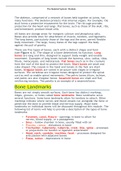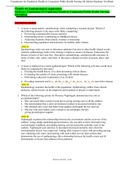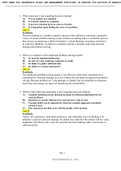Vivimwangi
On this page, you find all documents, package deals, and flashcards offered by seller vivimwangi.
- 3
- 0
- 0
Community
- Followers
- Following
3 items

the skeleton system.
The skull is formed by 22 bones: the cranium (8 bones) and facial bones (14 bones). The cranium protects the brains and is composed of eight bones fitted tightly together in adults. In newborns, certain bones are not completely formed and instead are joined by membranous regions called fontanelles (see Figure 4.4), commonly called “soft spots.” Fontanelles allow the bones of the skull to compress during childbirth and expand to accommodate a rapidly growing infant brain. These regions begin...
- Summary
- • 24 pages •
The skull is formed by 22 bones: the cranium (8 bones) and facial bones (14 bones). The cranium protects the brains and is composed of eight bones fitted tightly together in adults. In newborns, certain bones are not completely formed and instead are joined by membranous regions called fontanelles (see Figure 4.4), commonly called “soft spots.” Fontanelles allow the bones of the skull to compress during childbirth and expand to accommodate a rapidly growing infant brain. These regions begin...

Exam (elaborations) Adult Health Medical Surgical Nursing
1. A nurse is using analytic epidemiology when conducting a research project. Which of the following projects is the nurse most likely completing? a. Reviewing communicable disease statistics b. Determining factors contributing to childhood obesity c. Analyzing locations where family violence is increasing d. Documenting population characteristics for healthy older citizens
- Exam (elaborations)
- • 15 pages •
1. A nurse is using analytic epidemiology when conducting a research project. Which of the following projects is the nurse most likely completing? a. Reviewing communicable disease statistics b. Determining factors contributing to childhood obesity c. Analyzing locations where family violence is increasing d. Documenting population characteristics for healthy older citizens

TEST BANK FOR MANAGEMENT FUNCTIONS AND LEADERSHIP ROLES IN NURSING 9TH EDITION BY MARQUIS
Feedback: Decision making is a complex cognitive process often defined as choosing a particular course of action. Problem solving is part of decision making and is a systematic process that focuses on analyzing a difficult situation. Critical thinking, sometimes referred to as reflective thinking, is related to evaluation and has a broader scope than decision making and problem solving.
- Book
- Exam (elaborations)
- • 223 pages •
Feedback: Decision making is a complex cognitive process often defined as choosing a particular course of action. Problem solving is part of decision making and is a systematic process that focuses on analyzing a difficult situation. Critical thinking, sometimes referred to as reflective thinking, is related to evaluation and has a broader scope than decision making and problem solving.
